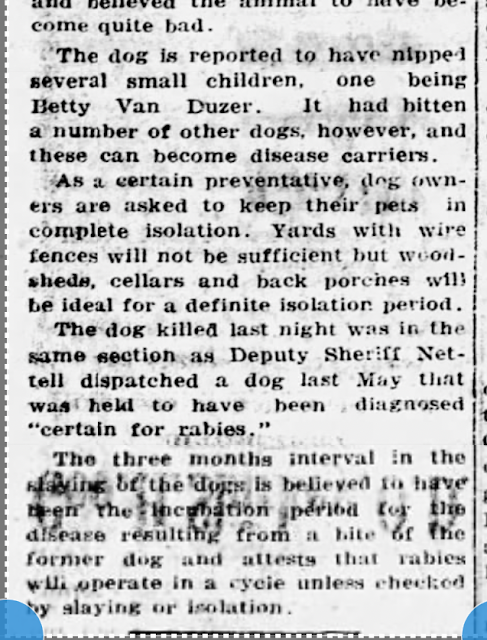Newspaper article from the Sacramento Bee, Monday, August 27, 1934
Newspapers.com
This week's theme is Health. I came across this little article a few months ago on Newspapers.com. I had never heard any stories about my grandmother being bitten by a rabid dog when she was little! And neither had Mom. This story was just too incredible. I had to do some more research...
The Morning Union August 23, 1934
Newspapers.com
So, the real story was that Grandma was bitten by a small dog. The paper in Sacramento had gotten a few details wrong, taken from the article below, as it turned out. What was going on in Grass Valley that summer?
The Morning Union August 23, 1934
Newspapers.com
This reporter described Grandma as a small child. Which wasn't quite true. But, the story peaked my interest. How did people survive rabies 100 years ago?
Margaret Elizabeth Hayes Van Duzer
November 7, 1917-March 26, 1991
This was Grandma's 1936 high school graduation picture, taken a year after her rabies scare.
The Morning Union August 25, 1034
Newspapers.com
Nowadays we vaccinate our pets against rabies and incidents in humans are rare, thank goodness. But 100 years ago that wasn't the case. How did doctors treat exposure to the fatal viral disease? What treatment did Grandma experience?
"Notice: This Rabies Vaccine Treatment will comprise a total of 21 doses, to be administered in numerical order, one dose each day for 21 days"....
National Museum of American History
Outside of a rabies vaccine outfit from the 1920's.
The vaccine, syringe, and plunger from the museum's rabies vaccine kit.
National Museum of American History
Louis Pasteur developed the first rabies vaccine in 1885, and getting treatment was difficult for most people as it was not widely available. People had to travel great distances and spend time and money receiving treatments in "Pasteur Institutes". By 1911 a new rabies kit was developed which could be shipped directly to doctors making treatment not only affordable, but widely available.
The treatment itself (in 1911) consisted of 25 injections of rabies vaccine: three on the first day, two on the second, two on the third, and one each day after for 18 days. This helped the body build up immunity to the virus. By 1920 the treatment had been reduced to 21 injections. Injections were given in the stomach. This is what my grandmother had to experience!
Today, the post exposure treatment for rabies consists of four doses of vaccine over a two week period, given in the arm. Which is what my daughter and son-in-law experienced this spring after waking up to a bat in their bedroom! It turns out this is standard protocol for someone who wakes up to a bat in their room. Apparently it is difficult to tell if you have been bitten or not. Doctors still take extra precautions, as once you've been bitten and symptoms develop the mortality rate is nearly 100 percent.
Rabies remains a serious disease, although it is more prevalent in Asia and Africa where vaccines are often inaccessible or unaffordable to marginalized populations. It causes 30,000-70,000 deaths a year, world-wide.
I am thankful that Grandma had a treatment available to her in August of 1934, although I couldn't imagine going through 21 days of injections in my stomach. It was something that had to be endured, as it would have been her only option aside from experiencing a very painful, early death. I have to wonder why this very scary incident of her teenage years was not passed down. It was a very interesting story to me, anyway!
Resources:
National Museum of American History: Surviving Rabies 100 Years Ago By Diane Wendt, NMAH October 28, 2013
World Health Organization: Rabies June 5, 2024
Relationship Reference:
Me->Margaret Hansen Boothby->Margaret Hayes Hansen (Betty)->Emma King Hayes Van Duzer










No comments:
Post a Comment